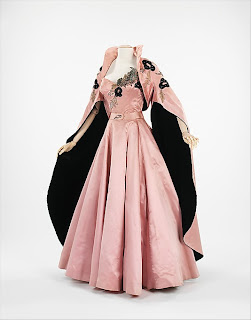One of my friends had a ‘Hollywood Glamour’ themed 21st birthday party last year. This seemed to me to be the perfect opportunity to make this dress, for which I had been making vague plans ever since seeing it in
High Style. Then I discovered it was worn by Ava Gardner in The Barefoot Contessa, in which she played an actress – how appropriate! I decided not to to make an exact copy as I don’t particularly like strapless sweetheart necklines and that decision also gave me a lot more freedom reinterpret other elements, such as the appliqués and the colour. As it turned out I couldn’t find the fabric in light pink and I very much like the colour of the fabric I found.
The dress is made from nine metres of poly-taffeta and three metres of velvet. I had never worked with real velvet before and it took me a while to get used to how it pushes away when sewing a seam, but the good quality just adds so much class to the outfit. The lace appliqués were cut from a lace fabric. It was the sort of fabric that, at $70 per metre, makes either a very expensive dress or in small amounts, very cheap trim – 20cm gave me 18 lovely appliqués at less than a dollar each.
 |
| (the fabric on the ironing board is a sleeve) |
To make the dress I adapted
Vogue 2903 (a vintage 50s pattern) and used
Simplicity 2442
as the basis for the halter. The dress closes with an invisible zip at
centre back and the halter just goes over my head. The bolero was also
adapted from Simplicity 2442. I cut the mock-up with a lot of extra
fabric around the collar and cut it back until it looked how I wanted. I
then forgot to interface the collar, but the fabric works well enough
without it. For the sleeves I cut the shape of a sleeve top into a
sheet, sewed it into the mock-up, put the mock-up on my dress form and
cut the rest of the material to the desired shape.
 |
| The sleeve pattern, with an iPhone for scale (it’s huge) |
I free-handed the shape for the velvet appliqués and, after ironing them
on, machine satin-stitched around them. The lace appliqués were also
first affixed by an iron-on adhesive and then secured by hand. They took
around two hours each, because I had to be very careful to sew through
the loops of the lace weave.
In the grand tradition of costuming, the dress was still being sewn
right to the last minute and I wore it to the party with the sleeve
linings safety-pinned in, one of the appliqués only ironed on and not
sewn and no appliqué on the front bodice. But it was still very well
received and I loved wearing it.
 |
| Look! I made something neat on the inside. |
I did the velvet on the bodice appliqué differently from the ones on the
bolero. I satin-stitched the velvet to a separate piece of taffeta
which I hand-sewed to the bodice preventing any misshaping and keeping
the inside cleaner. The bodice appliqués are all beaded and sequined
which looks really nice (I didn’t have time to even consider beading on
the bolero) and was so much fun that I spent the rest of the week
wishing I had more to do.
I entered this dress in the Canberra Show. I won first place in my
section and reserve champion (for non-professional entrants with more
than 2 years experience).
I am incredibly happy with this
outfit. It’s one of the best quality pieces I’ve made and it was really
nice to have a dress that I’d long admired, but had no particular
expectations that it would become a reality.
(It's a great dress for pretending to be a helicopter)





















